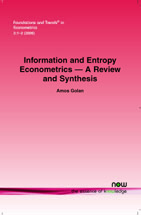Information and Entropy Econometrics — A Review and Synthesis
By Amos Golan, Department of Economics, American University, USA, agolan@american.edu
Abstract
The overall objectives of this review and synthesis are to study the basics of information-theoretic methods in econometrics, to examine the connecting theme among these methods, and to provide a more detailed summary and synthesis of the sub-class of methods that treat the observed sample moments as stochastic. Within the above objectives, this review focuses on studying the inter-connection between information theory, estimation, and inference. To achieve these objectives, it provides a detailed survey of information-theoretic concepts and quantities used within econometrics. It also illustrates the use of these concepts and quantities within the subfield of information and entropy econometrics while paying special attention to the interpretation of these quantities. The relationships between information-theoretic estimators and traditional estimators are discussed throughout the survey. This synthesis shows that in many cases information-theoretic concepts can be incorporated within the traditional likelihood approach and provide additional insights into the data processing and the resulting inference.
Information and Entropy Econometrics
Information and Entropy Econometrics - A Review and Synthesis summarizes the basics of information theoretic methods in econometrics and the connecting theme among these methods. The sub-class of methods that treat the observed sample moments as stochastic is discussed in greater details.
Information and Entropy Econometrics - A Review and Synthesis focuses on inter-connection between information theory, estimation and inference, provides a detailed survey of information theoretic concepts and quantities used within econometrics and then show how these quantities are used within IEE, and pays special attention for the interpretation of these quantities and for describing the relationships between information theoretic estimators and traditional estimators. Readers need a basic knowledge of econometrics, but do not need prior knowledge of information theory. The survey is self contained and interested readers can replicate all results and examples provided. Whenever necessary the readers are referred to the relevant literature.
Information and Entropy Econometrics - A Review and Synthesis will benefit researchers looking for a concise introduction to the basics of IEE and to acquire the basic tools necessary for using and understanding these methods. Applied researchers can use the book to learn improved new methods, and applications for extracting information from noisy and limited data and for learning from these data.
